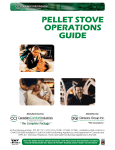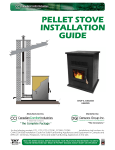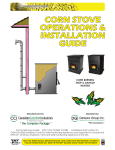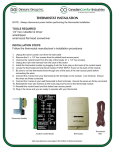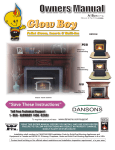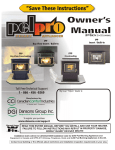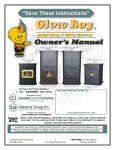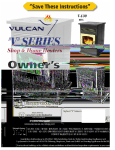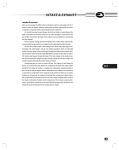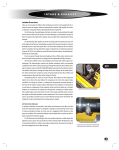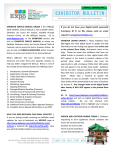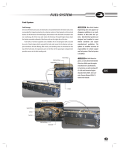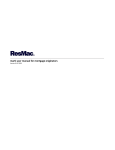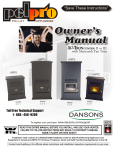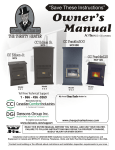Download Dansons Group CAN/CSA B365 User's Manual
Transcript
PELLET STOVE OPERATIONS GUIDE Manufactured for Manufactured by For the following models: FPP, IPP, CC1, CC2, CC3, CCGB1, CCGB2, CCGB3 Installations shall conform to: CAN/CSA B365 Installation Code For Solid-Fuel-Burning Appliances and Equipment in Canada and NFPA 211 Chimney, Fireplaces, Vents and Solid Fuel Burning Appliances in the USA READ THIS ENTIRE MANUAL BEFORE INSTALLING YOUR PELLET STOVE/HEATER/INSERT. FAILURE TO FOLLOW INSTRUCTIONS MAY RESULT IN PROPERTY DAMAGE, BODILY INJURY OR EVEN DEATH FOREWORD TO NEW OWNERS Dear Pellet Appliance Owner, Congratulations on the purchase of your wood pellet appliance. You have selected the finest in residential wood pellet heating technology. This OPERATIONS GUIDE will walk you through the initial setup of your pellet stove, from first light to fine tuned adjustments. We have also included detailed information on cleaning and maintenance as well as wood pellet fuel facts. Please note the following points regarding stove installation and pellet heating in general: - Whether you install your stove yourself or hire a professional installer, a quality installation is a must for the safety of your family as well as efficient, satisfactory operation. - Initial setup of the stove is the most important step to ensure consistent, comfortable operation. - Know the quality and characteristics of the pellets you burn. Pellets can vary greatly from company to company, from load to load and even from bag to bag. - Be dilligent in your cleaning program. - Remember that most operational dilemmas with pellet stoves arise from improper installation, poor quality pellets, lack of timely cleaning or incorrect air flow adjustment. With a minimum amount of consistent care, your pellet appliance will provide years of clean, efficient, comfortable and environmentally sound heating. UPDATES Updated manuals, product registration and warranty information can be found on our website: www.dansons.com/support Thank you for selecting our wood pellet stove! Sincerely, Dansons Group Inc. and Canadian Comfort Industries We do NOT recommend pellet stoves as your only source of heat. Do NOT install in a sleeping room. Use of outside air is highly recommended with our pellet stoves, heaters and inserts. Do not operate with the front door or hopper lid open. Keep children, furniture, fixtures and all combustibles away from any heating appliance. Installation and use of a carbon monoxide detector is highly recommended. 2 STARTING UP YOUR PELLET STOVE 1 STARTUP CHECKLIST Please make certain you have completed the following checklist before proceeding: . . . . . . . . . . Unit is plugged into a 3 pronged grounded outlet Burn pot is clean, level & seated properly Front door of the stove is closed Screened pellets are in the hopper Pellet fuel complies with PFI standards (pelletheat.org) Unit is NOT plugged into a GFI outlet (ground fault interruptor) FOR NEW INSTALLATIONS: Used only PL or L approved venting Sealed vent connections with high temp RTV sealant and allow sealant to cure for 24 hours Make sure #1 trim pod is set to 9 o’clock position (see pg 5) Air inlet damper is OPEN to between 1/4” and 1/2” (see ‘Initial Setup’ section on page 4) We STRONGLY recommend the use of a surge protector to protect the circuitry in your control board. 2 LIGHTING PROCEDURE Procedures listed will work with both Push firmly on the START / FEED RATE button. AcuTron II & AcuTron III control boards. A The COMBUSTION FAN (exhaust) will start and operate at full speed for 60 seconds, then will slow to match the startup rate B The CONVECTION FAN (heat circulation) will start and the LED will go solid on LOW setting C The AUGER CYCLE LED will go solid for 3 seconds indicating the signal is being sent to auger motor D The IGNITER LED will light up solid and the igniter will begin to heat up 3 During first-time startup procedure, your auger system IS NOT PRIMED (meaning pellets have not filled the entire auger system yet). To solve this, simply press theSTART / FEED RATE button again. SAMPLE GRATE WITH PELLETS BURN POT 4 HOPPER On a primed auger system, pellets will begin to fall into the BURN GRATE, and the igniter will automatically ignite pellets in approximately 3 to 7 minutes. PRIMED AUGER SYSTEM SAMPLE IGNITER Adjust FUEL RATE and FAN SPEED to your desired settings If the fire does not start, your stove will continue to feed pellets and run the fans for 15 minutes. The stove will then automatically shut off. (see PELLET STOVE ADJUSTMENTS If the stove fails to ignite a second time, refer to the TROUBLESHOOTING section of your manual or contact your pellet stove dealer. section). NOTE: New stoves can emanate an odor during the initial few hours of burning while the paint cures. Ventilating the room is strongly recommended until the odors disappear. 3 PELLET STOVE ADJUSTMENTS INITIAL SETUP It is critical for the correct operation of your stove that the burn grate, air inlet damper, combustion fan speed and fuel rate be set correctly! 1 START THE APPLIANCE AS PER THE LIGHTING INSTRUCTIONS. The igniter light MUST be off in order to begin further adjustments; this can take from 10-15 minutes to occur. Let the stove run until the igniter light goes off, then push the START / FEED RATE button several times until feed rate #4 LED lights up. Let stove run for 10-15 minutes. Now you will adjust the air inlet damper. This will have to be set because the factory must be able to accomodate a wide range of installations and elevations as well as fuel length and quality. 2 AIR INLET DAMPER Slide open or close the damper as needed to obtain a fire that is brisk enough to carry ash out of the grate, but not so brisk that it carries whole pellets out as well; this is known as popcorning. Normally, you should find that the damper will need to be 1/4” to 1/2” open. This may vary with length of vent run, pellet quality and elevation. The best way to set this is at feed rate #4. Adjust the damper rod 1/8” at a time, letting the stove burn for 1-2 minutes per adjustment, until popcorning ceases. A Damper Rod (normally located on rear side panel) Fresh Air Inlet Damper Rod (inside stove) DEFINITIONS PELLETS BLOWN OUT OF BURN GRATE POPCORNING AIR FLOW B Popcorning is the result of incorrectly set air flow, causing fresh unburned pellets (or barely ignited pellets) to be carried out of the burn grate and into the ash bin by high air flow. This occurs before more pellets have fallen into the burn grate (ie. It’s AIR that carries the pellets out, not the impact of newly dropped pellets. See SPARKING). A pellet that has been ‘popcorned’ out of the burn grate can glow for anywhere from several seconds to several minutes. Figures A and B show popcorning at #1 feed rate. SPARKING C Sparking occurs from the impact of fresh pellets being dropped into the burn pot and knocking parts of burning pellets out. Also, the natural burning of wood can create sparks. Sparks will glow in the ash bin generally for several seconds before burning out. Figure C shows sparking at #4 feed rate. PLEASE NOTE: Sparking is normal. Popcorning can be remedied by following step 2 above. 4 PELLET STOVE ADJUSTMENTS 3 FINE TUNING YOUR STOVE Once the damper rod is set and your pellets are burning steadily (ie. no popcorning), you are ready to fine tune your stove. Fine tuning is required due to the differences in installation configuration, geography, insulation of the home, and quality of pellets. Do NOT use a metal object to adjust your trim pods. Try using a plastic non-metallc object (eg. insulated shaft screwdriver, pen cap, etc.) First, switch to feed rate #1 by pressing the START / FEED RATE button until the #1 LED lights up. A Turn the #1 trim pod COUNTER CLOCKWISE until the dial stops, then turn back to 9-3 o’clock position as illustrated. B Turn the #4 trim pod CLOCKWISE until the dial stops, then turn back to 9-3 o’clock position as illustrated. TRIM PODS WITH FACTORY DEFAULT SETTINGS FUEL FEED RATE SETTING #1 (LOW) CLOCKWISE By adjusting these trim pods as described above, you are ensuring that your stove is now at its optimal settings. You may need to adjust the feed rates after a few days of burning. DECREASES feed rate FUEL FEED RATE SETTING #4 (HIGH) COUNTERCLOCKWISE INCREASES feed rate FUEL RATES At this point, your stove should still be running on the #1 setting (low). Let this burn for approximately 10 minutes before making any further adjustments. Fuel feed rate at the lowest (#1) and highest (#4) settings can be changed by adjusting the #1 or #4 trim pods located on the control panel. To INCREASE fuel feed rate, turn the trimmer COUNTER CLOCKWISE. To DECREASE fuel feed rate, turn the trimmer CLOCKWISE. IMPORTANT: The #1 and #4 trim pod dials ONLY adjust fuel feed rates 1 and 4. WARNING: Adjusting FEED RATE #1 too low (clockwise) may cause your stove to shut down. 5 WOOD PELLET FUEL The performance of your pellet appliance is greatly affected by the type and quality of wood pellets burned. As the heat output of various brands of pellets differs, so will the performance and heat output of your appliance. PELLET QUALITY Your pellet stove is designed to burn APFI/FFI ‘Premium’ or ‘Standard’ quality wood pellets. Pellets that are soft contain excessive amounts of loose sawdust, have been or are wet, and produce clinkers or heavy ash will result in reduced performance and may actually cause the fire to go out. PELLET CONSUMPTION Fuel consumption will vary somewhat between fuel brands and stoves. The following ‘rough guide’ to pellet usage may be useful in assessing your stove’s operation, for ordering fuel and in providing information to your authorized pellet stove dealer. Setting Approximate Burn Times 120 lb Hopper 300 lb Hopper Amount of Pellets Burned 1 40 - 80 hours 100 - 200 hours 1.5 - 3 lbs per hour 2 35 - 48 hours 86 - 120 hours 2.5 - 3.5 lbs per hour 3 27 - 35 hours 67 - 86 hours 3.5 - 4.5 lbs per hour 4 22 - 30 hours 55 - 75 hours 4 - 5.5 lbs per hour Fuel flow and burn times quoted are approximate and may vary with type of fuel used. FACTORS AFFECTING PELLET FEED RATES Generally, the smaller, harder and cleaner (free from fines) the pellets are, the faster they will feed at a given setting and vice versa. The extremes in pellet size and quality can cause several hours of difference in burn time for a 40 lb bag of pellets. Heat production is directly related to the pounds of fuel burned per hour. As fuel consumption goes down so will heat output and vice versa. Pellet feed rate, at the same fuel settings, may vary greatly from brand to brand and may vary somewhat from batch to batch within the same brand. We recommend the use of screened pellet fuel in order to reduce the amount of fines your stove will have to cope with. 6 WOOD PELLET FUEL DEFINITIONS ASH Ash is a natural product of burning wood. As the amount of ash in the wood increases, the amount of ash left behind after burning high-ash wood pellets will increase. High quality pellets will produce less ash and fewer clinkers than lower quality pellets. CLINKER Clinkers are solid, glassy or porous accumulations of incombustible matter that may result from burning some types of wood pellets. Clinkers are formed at the bottom of the burn grate and, if left undisturbed, will build up and cut off combustion air. As clinkers grow, the fire becomes orange/brown and ‘lazy’. Pellets may build up in the burn grate, the firebox & window may become sooty, and exhaust gases may become smoky. FINES Fines are pieces of sawdust that were not properly formed or are the result of pellets breaking down during handling, transporting and storage. Fines adversely affect the operation and heat production of pellet appliances, and they greatly increase the requirements for general cleaning and maintenance. Fines cause pellets to feed more slowly, thus reducing the amount of heat produced at any given heat setting. NOTE: It is much easier to remove fines from pellets before they are placed in the stove than it is to service your stove for a plugged hopper, jammed auger or plugged exhaust system. Pellets with excessive sawdust may be screened to remove most of the fines. Pellet screeners may be built or purchased from most pellet stove dealers. PFI PELLET STANDARDS For the Pellet Fuel Institute (PFI), standards for residential quality pellets are as follows: Length: Diameter: Fines: Salts: Ash Content: - Premium Quality - Standard Quality 1.5 inches maximum 0.235 to 0.350 inches (approx. 1/4” to 3/8”) .2 lb maximum per 40 lb bag 0.005% by weight maximum 0.75% by weight maximum (0.3 lb per 40 lb of pellets) 2.5% by weight maximum (1 lb per 40 lb of pellets) Find out more at www.pelletheat.org NOTE: Because Dansons Group Inc. and Canadian Comfort Industries have no control over the quality of pellets that you use, we assume no liability caused by issues relating to the quality of chosen pellets. 7 REQUIRED ROUTINE CLEANING WARNING: Disconnect the electrical cord prior to opening the sides of your stove or opening the exhaust system for any inspection, cleaning, maintenance or service work. NEVER perform any inspection, cleaning, maintenance or service on a HOT STOVE or when the cord is plugged in. Proper care of your pellet stove or heater is required for peak, sustained performance. The need for frequent cleaning depends upon: - amount of pellets burned - pellet quality - length of time since the previous cleaning - quality of the fire RECOMMENDED MAINTENANCE SCHEDULE W WEEKLY (or every 2-3 days) S SEASONALLY (or every 1-2 tons of fuel burned) BURN GRATE - Clean as needed, scraping off any residue that may stick to the grate bottom or sides. Ensure the holes are clean and unrestricted. CAUTION: When replacing the grate, make sure it is properly seated in the burn pot (ie. sitting level, front to back, left to right). W BURN POT - Remove the burn grate. Clean out the burn pot as needed. Do not push the ash to the back of the pot as this will restrict the air flow and affect the performance of this appliance. W HEAT TUBES ASH BIN - Monitor the ash level on a weekly basis. Ash content is a good indication of fuel efficiency and quality. A HOME SHOP VAC MAY BE USED TO REMOVE ASH FROM YOUR STOVE *ONLY* WHEN THE ASHES HAVE COOLED. Refer to your TECHNICAL GUIDE for more information on the safe disposal of ash. W HOPPER SCRAPER ROD AUGER AUGER MOTOR WINDOW EXHAUST REAR BURN PLATE BURN GRATE AIR INTAKE BURN POT FAN MOTOR ASH BIN HEAT TUBES - With your stove’s main door closed, pull the HEAT TUBE SCRAPER ROD forward and backward a few times. As different types of pellets produce different amounts of ash, cleaning the tubes enables the heat exchange to operate efficiently. CAUTION: On a burning stove, the scraper rod is HOT or may not move due to metal expansion. W FREESTANDING STOVE SHOP HEATER HEAT TUBES SCRAPER ROD HOPPER AUGER WINDOW REAR BURN PLATE AUGER MOTOR EXHAUST BURN GRATE BURN POT AIR INTAKE ASH TRAPS - Remove the rear burn plate from the FAN MOTOR ASH BIN firebox area. This will expose the 2 ash traps and the pellet fuel drop chute. Fly ash may be removed by vacuuming inside the trap area with an approved ash vacuum (A HOME SHOP VAC MAY BE USED TO REMOVE ASH FROM YOUR STOVE *ONLY* WHEN THE ASHES HAVE COOLED). A bottle cleaning brush can help remove build-up inside the traps. S WINDOW CLEANING - Clean your window as needed with an approved wood appliance glass cleaner to remove heavy build-up on the window. Do NOT use abrasive chemical cleaners. A 000 steel wool pad may be used to scour any hard-to-remove creosote and carbon accumulation. Finish your cleaning procedure by washing down the glass with vinegar & water to remove cleaner residue. DO NOT OPERATE YOUR STOVE WITH BROKEN GLASS! W 8 REQUIRED ROUTINE CLEANING WARNING: Disconnect the electrical cord prior to opening the sides of your stove or opening the exhaust system for any inspection, cleaning, maintenance or service work. NEVER perform any inspection, cleaning, maintenance or service on a HOT STOVE or when the cord is plugged in. (cont’d) HOPPER CLEANING - Check the hopper periodically to determine if there is any sawdust or pellets that are sticking to the hopper surface and clean as needed. W GLASS REPLACEMENT - In the event you need glass replacement, only Neo-Ceram of the correct size and thickness may be used. Contact your Authorized Dealer to obtain this glass. DO NOT OPERATE YOUR STOVE WITH BROKEN GLASS! DOOR GASKET - Inspect the main door gasket periodically. The main door may be removed to have frayed, broken or compacted gaskets replaced by your Authorized Dealer. S FAN MOTORS - Clean the intake on the CONVECTION FAN (circulation) as well as the holes on the motors of both COMBUSTION and CONVECTION FANS annually. Disassemble the COMBUSTION FAN and clean out the internal fan blades as part of your fall season startup. S FRESH AIR INTAKE - Inspect periodically to be sure that it is not clogged with any foreign materials. A plugged screen will restrict or shut off combustion air and cause a fire to burn poorly or die out. W GOLD/BRASS TRIM CLEANING - Use a damp cloth to clean your door and trim. DO NOT USE ANY ABRASIVE CLEANSERS AS YOU WILL REMOVE OR SCRATCH THE PLATING! W INSPECT AND CLEAN VENTING - Fly ash will collect in the exhaust venting system and restrict the flow of flue gases. Check the clean out tees and elbows in the system periodically to determine the required schedule of cleaning. To remove dust from the vent pipe, lightly tap on the pipe to dislodge loose ash. Open the bottom of the tee to dump the ash, then use an ash vacuum to remove as much ash as possible from the pipe. 3” and 4” chimney brushes are available for cleaning. If the exhaust system has a screen on it, frequently clean the screen. A plugged screen will shut down the stove or cause the fire to burn poorly or die out. S PAINTED SURFACES - Painted surfaces may be wiped down with a damp cloth. If scratches appear or you wish to renew your paint, contact your Dealer to obtain a can of ‘satin black’ (Stove Brite brand) TIP: Use a hair dryer to warm the surface prior to touching up the paint; this helps to reduce paint runs. NOTE: Do not use any other brand than Stove Brite as they may not be compatible. S SPRING SHUTDOWN - After the last burn in the spring, complete the following tasks: - remove pellets from hopper and auger - vacuum out the hopper - thoroughly clean the burn grate, burn box, ash traps and ash bin - consider spraying the inside of the cleaned hopper with an aerosol silicone spray if your stove is in a high humidity area - thoroughly clean exhaust system (see above) A yearly servicing and cleaning by your Authorized Dealer is recommended. Please consult with your Dealer for availability of this service, time involved and possible fees. 9 GUIDE TO TROUBLESHOOTING TROUBLESHOOTING Proper cleaning, maintenance and use of quality pellets will prevent common operational issues with your pellet stove. However, when your appliance is simply operating poorly or not at all, the following troubleshooting tips may be helpful. WARNING: Disconnect the electrical cord prior to opening the sides of your stove or opening the exhaust system for any inspection, cleaning, maintenance or service work. NEVER perform any inspection, cleaning, maintenance or service on a HOT STOVE or when the cord is plugged in. PROBLEM SOLUTION Orange, lazy flame - clean out burn grate and burn pot - examine ash traps, clean as needed - check exhaust system, clean as needed - refer to PELLET STOVE ADJUSTMENTS section of this manual Sooty window - check outside air and exhaust screens, unplug if necessary - make sure main door and (if applicable to your model) ash bin cover are tightly closed - refer to PELLET STOVE ADJUSTMENTS section of this manual Pellets build up in the burn grate - check main and (if applicable to your model) ash door gaskets, replace if worn - check pellet fuel; replace if moist, wet, dirty or high in fines - refer to PELLET STOVE ADJUSTMENTS section of this manual - contact with your Authorized Dealer for service Fire goes out Fans will not run when START / FEED RATE button is pushed - verify that the appliance is plugged in and electricity is running to that outlet; verify that the outlet is NOT GFI (ground fault indicator) - refer to PELLET STOVE ADJUSTMENTS section of this manual - contact your Authorized Dealer for service Pellets will not feed - hopper is empty; fill the hopper with fresh, clean, dry pellets - fuel switch has not been pushed to ‘ON’ (some models) - auger system or controls need service - exhaust system is plugged; clean venting - refer to PELLET STOVE ADJUSTMENTS section of this manual - contact with your Authorized Dealer for service Stove runs 15 minutes, then shuts off - startup fire did not catch; light a new fire by pressing the START / FEED RATE button again - contact with your Authorized Dealer for service Fans do not shut off when stove cools down - contact with your Authorized Dealer for service Ash and/or pellet dust is accumulating in the house, or the smell of smoke is detected - check for and correct any leaks in the exhaust system - take greater care in handling ashes, cleaning window glass, opening the doors more slowly and in filling the hopper - contact with your Authorized Dealer for service CAUTION: The electrical, auger and digital control components of your stove are not owner serviceable. Call your Authorized Dealer for proper diagnosis of problems and service for those components. For more detailed troubleshooting tips, please visit www.dansons.com/support 10 LIMITED WARRANTY CANADIAN COMFORT INDUSTRIES (CCI) LIMITED WARRANTY CCI wood pellet and corn appliances carry a one (1) year -parts only- on electrical components and a five (5) year limited warranty from the date of sale to the original owner against defects and workmanship on all steel parts (excluding the burn grate and the heat tube scraper / rod). If defective in material or workmanship, during the warranty period, CCI will, at its option, repair or replace the product as described below. There specifically is NO warranty on paint or plated surfaces, glass, burn grate, fire brick and all gaskets or against damage caused by corrosion. There is no warranty coverage for variances in fuel feed rates. BTU heat rating will vary with different fuel conditions and is not considered a defect if the unit does not feed a constant amount of fuel. The warranty above constitutes the entire warranty with respect to Canadian Comfort Industries. CCI MAKES NO OTHER WARRANTY, EXPRESSED OR IMPLIED, INCLUDING “ANY” WARRANTY OF MERCHANTABILITY, OR WARRANTY OF FITNESS FOR A PARTICULAR PURPOSE. No employee, agent, dealer, or other person is authorized to give any warranty on behalf of CCI. This warranty does not apply if the product has been altered in any way after leaving the factory. CCI and its agents assume no liability for “resultant damages of any kind” arising from the use of its products. In addition, the manufacturer and its warranty administrator shall be held free and harmless from liability from damage to property related to the operation, proper or improper, of the equipment. THERE ARE NO WARRANTIES WHICH EXTEND BEYOND THE DESCRIPTION ON THE FACE HEREOF. THESE WARRANTIES APPLY only if the device is installed and operated as recommended in the user’s manual. THESE WARRANTIES WILL NOT APPLY if abuse, accident, improper installation, negligence, or use beyond rated capacity causes damage. HOW TO MAKE A CLAIM – Any claim under this warranty should be made to the dealer from whom this appliance was purchased. Then contact is made with the manufacturer, giving the model and serial numbers, the date of purchase, your dealer’s name and address, plus a simple explanation of the nature of the defect. THIS WARRANTY IS LIMITED TO DEFECTIVE PARTS – REPAIR AND/OR REPLACEMENT AT CCI’s OPTION AND EXCLUDES ANY INCIDENTAL AND CONSEQUENTIAL DAMAGES CONNECTED THEREWITH. A DEFECTIVE PART DOES NOT WARRANT THE REPLACEMENT OF THE ENTIRE UNIT. WARRANTY EXCLUSIONS: Failure due, but not limited to, fire, lightning, acts of God, power failures and/or surges, rust, corrosion and venting problems are not covered. AUGER JAMS ARE NOT COVERED UNDER WARRANTY. Damage and/or repairs including but not limited to; knobs, handles, door gaskets, log sets, paint and plated surfaces – trim, baffles, louvers or handles. Additional exclusions for corn stoves are burnpot housing weldment and burnpot warpage (corn or pellet). Additional or unusual utility bills incurred due to any malfunction or defect in equipment are not covered. REMOVAL OR REINSTALLATION COSTS ARE NOT COVERED BY THIS WARRANTY. CCI LIABILITY IS LIMITED TO THE WHOLESALE COST OF THE STOVE. Some states do not allow the exclusion or limitation of incidental or consequential damages, or limitations of implied warranties; therefore the limitations of exclusions set forth in this warranty may not apply to you. This warranty gives you specific legal rights, and you may have other rights, which vary from state to state. All disputes relating to this warranty shall be tried before the courts of Alberta, Canada. Your purchase must be registered with Canadian Comfort Industries. This can be done at: www.dansons.com/support or by faxing your proof of purchase to us at: 1-877-303-3135. 11 My local dealer is: To register your purchase, visit www.dansons.com/support Technical Support Toll Free Monday to Friday, 11 am to 7 pm EST 1-888-470-7011 or Monday to Friday, 9 am to 8 pm EST Saturday, 11 am to 7 pm EST 1-877-303-3134 1-866-456-9269 COPYRIGHT Copyright 2006, Canadian Comfort Industries. All rights reserved. No part of this manual may be copied, transmitted, transcribed, stored in a retrieval system in any form or by any means without the expressed written permission of: Canadian Comfort Industries 26319 Twp Rd 531 Acheson, AB Canada T7X 5A3 1-877-303-3134












